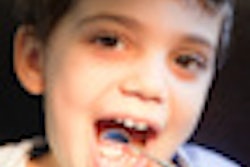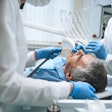
A new global survey highlights how dental care in the school environment is helping to ensure a healthy life and social equality in dental health -- even in developing countries.
The survey was conducted by the University of Copenhagen and the World Health Organization (WHO).
"Children in Scandinavia generally have healthy teeth and gums, largely on account of dental care in schools for all children, the arrival of fluoride toothpaste on the market, a healthy lifestyle, and high living standards," said study co-author Poul Erik Petersen, DDS, a professor in the department of odontology at the University of Copenhagen and a global health specialist. "But the situation in the poorest countries of the world is very different to that in Scandinavia." However, the WHO's Health Promoting Schools Initiative is gaining ground at a global level, he noted, adding that it is gradually wiping out the social inequalities in dental health.
The study was based on data about health and dental care from 61 countries that have health programs in schools, and the findings were published in Community Dental Health (December 2013, Vol. 30:4, pp. 204-218).
“Schools that ... offer all children education in dental health and disease prevention are generally well-placed to set children on a path to a healthy lifestyle throughout their lives.”
"Our findings reveal that those schools that have set up healthy school environments -- and which offer all children education in dental health and disease prevention -- are generally well-placed to set children on a path to a healthy lifestyle throughout their lives, with regard to issues such as diet, physical exercise, tobacco, alcohol, and HIV control," Dr. Petersen said.
About 60% of the countries that took part in the study teach students how to brush their teeth, but not all countries have access to clean water and the necessary sanitary conditions. This is a major challenge for the health and school authorities in Asia, Latin America, and Africa, in particular.
"Countries in these regions are battling problems involving the sale of sugary drinks and sweets in the school playgrounds," Dr. Petersen said, noting that selling sweets is often a source of extra income for school teachers, who are poorly paid.
The biggest challenge to improving dental health in low-income countries is the lack of financial resources and trained staff. Schools in the poorest countries, therefore, devote little or no time to dental care, and they similarly make only very limited use of fluoride in preventive care. Also, the healthy schools in low-income countries find it harder to share their experience and results.
Social inequality in dental health and care is a serious problem all over the world, according to the study authors.
"However, inequality is greater in developing countries where people are battling with limited resources, an increasing number of children with toothache, children suffering from HIV/AIDS and infectious diseases -- combined with a lack of preventive measures and trained healthcare staff," Dr. Petersen said.
Even affluent countries such as Denmark have social inequalities regarding dental care, despite the fact that dental health there is much improved among children and adults, the study authors noted. Socially and financially disadvantaged groups have higher rates of caries and oral problems compared with more affluent groups, Dr. Petersen said.
The Danish model for dental care was established in the 1970s and 1980s, with the goal of ensuring good dental health for children and young people, regardless of their social backgrounds.
"The long-term effect is now becoming apparent among adults and elderly people, who have maintained a good mouth, healthy teeth and gums, and a strong quality of life," Dr. Petersen said. "Unfortunately, not all countries in the world are able to operate a school system of this kind."



















